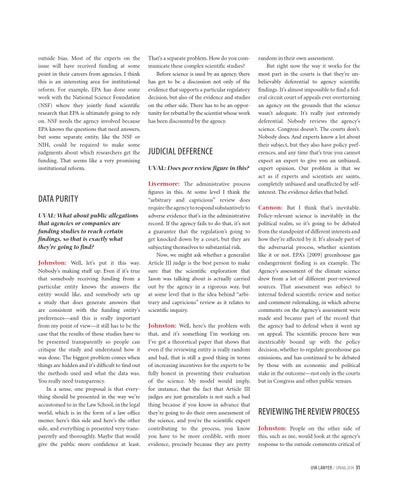outside bias. Most of the experts on the issue will have received funding at some point in their careers from agencies. I think this is an interesting area for institutional reform. For example, EPA has done some work with the National Science Foundation (NSF) where they jointly fund scientific research that EPA is ultimately going to rely on. NSF needs the agency involved because EPA knows the questions that need answers, but some separate entity, like the NSF or NIH, could be required to make some judgments about which researchers get the funding. That seems like a very promising institutional reform.
That’s a separate problem. How do you communicate these complex scientific studies? Before science is used by an agency, there has got to be a discussion not only of the evidence that supports a particular regulatory decision, but also of the evidence and studies on the other side. There has to be an opportunity for rebuttal by the scientist whose work has been discounted by the agency.
JUDICIAL DEFERENCE UVAL: Does peer review figure in this? Livermore: The administrative process
DATA PURITY UVAL: What about public allegations that agencies or companies are funding studies to reach certain findings, so that is exactly what they’re going to find? Johnston: Well, let’s put it this way. Nobody’s making stuff up. Even if it’s true that somebody receiving funding from a particular entity knows the answers the entity would like, and somebody sets up a study that does generate answers that are consistent with the funding entity’s preferences—and this is really important from my point of view—it still has to be the case that the results of those studies have to be presented transparently so people can critique the study and understand how it was done. The biggest problem comes when things are hidden and it’s difficult to find out the methods used and what the data was. You really need transparency. In a sense, one proposal is that everything should be presented in the way we’re accustomed to in the Law School, in the legal world, which is in the form of a law office memo: here’s this side and here’s the other side, and everything is presented very transparently and thoroughly. Maybe that would give the public more confidence at least.
figures in this. At some level I think the “arbitrary and capricious” review does require the agency to respond substantively to adverse evidence that’s in the administrative record. If the agency fails to do that, it’s not a guarantee that the regulation’s going to get knocked down by a court, but they are subjecting themselves to substantial risk. Now, we might ask whether a generalist Article III judge is the best person to make sure that the scientific exploration that Jason was talking about is actually carried out by the agency in a rigorous way, but at some level that is the idea behind “arbitrary and capricious” review as it relates to scientific inquiry.
Johnston: Well, here’s the problem with that, and it’s something I’m working on. I’ve got a theoretical paper that shows that even if the reviewing entity is really random and bad, that is still a good thing in terms of increasing incentives for the experts to be fully honest in presenting their evaluation of the science. My model would imply, for instance, that the fact that Article III judges are just generalists is not such a bad thing because if you know in advance that they’re going to do their own assessment of the science, and you’re the scientific expert contributing to the process, you know you have to be more credible, with more evidence, precisely because they are pretty
random in their own assessment. But right now the way it works for the most part in the courts is that they’re unbelievably deferential to agency scientific findings. It’s almost impossible to find a federal circuit court of appeals ever overturning an agency on the grounds that the science wasn’t adequate. It’s really just extremely deferential. Nobody reviews the agency’s science. Congress doesn’t. The courts don’t. Nobody does. And experts know a lot about their subject, but they also have policy preferences, and any time that’s true you cannot expect an expert to give you an unbiased, expert opinion. Our problem is that we act as if experts and scientists are saints, completely unbiased and unaffected by selfinterest. The evidence defies that belief.
Cannon: But I think that’s inevitable. Policy-relevant science is inevitably in the political realm, so it’s going to be debated from the standpoint of different interests and how they’re affected by it. It’s already part of the adversarial process, whether scientists like it or not. EPA’s [2009] greenhouse gas endangerment finding is an example. The Agency’s assessment of the climate science drew from a lot of different peer-reviewed sources. That assessment was subject to internal federal scientific review and notice and comment rulemaking, in which adverse comments on the Agency’s assessment were made and became part of the record that the agency had to defend when it went up on appeal. The scientific process here was inextricably bound up with the policy decision, whether to regulate greenhouse gas emissions, and has continued to be debated by those with an economic and political stake in the outcome—not only in the courts but in Congress and other public venues.
REVIEWING THE REVIEW PROCESS Johnston: People on the other side of this, such as me, would look at the agency’s response to the outside comments critical of
UVA LAWYER / SPRING 2014 31
